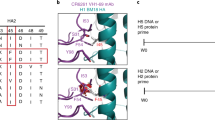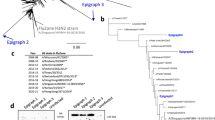Abstract
The antibody response to influenza is primarily focused on the head region of the hemagglutinin (HA) glycoprotein, which in turn undergoes antigenic drift, thus necessitating annual updates of influenza vaccines. In contrast, the immunogenically subdominant stem region of HA is highly conserved and recognized by antibodies capable of binding multiple HA subtypes1,2,3,4,5,6. Here we report the structure-based development of an H1 HA stem–only immunogen that confers heterosubtypic protection in mice and ferrets. Six iterative cycles of structure-based design (Gen1–Gen6) yielded successive H1 HA stabilized-stem (HA–SS) immunogens that lack the immunodominant head domain. Antigenic characterization, determination of two HA–SS crystal structures in complex with stem-specific monoclonal antibodies and cryo-electron microscopy analysis of HA–SS on ferritin nanoparticles (H1–SS–np) confirmed the preservation of key structural elements. Vaccination of mice and ferrets with H1–SS–np elicited broadly cross-reactive antibodies that completely protected mice and partially protected ferrets against lethal heterosubtypic H5N1 influenza virus challenge despite the absence of detectable H5N1 neutralizing activity in vitro. Passive transfer of immunoglobulin from H1–SS–np–immunized mice to naive mice conferred protection against H5N1 challenge, indicating that vaccine-elicited HA stem–specific antibodies can protect against diverse group 1 influenza strains.
This is a preview of subscription content, access via your institution
Access options
Subscribe to this journal
Receive 12 print issues and online access
$209.00 per year
only $17.42 per issue
Buy this article
- Purchase on Springer Link
- Instant access to full article PDF
Prices may be subject to local taxes which are calculated during checkout




Similar content being viewed by others
References
Throsby, M. et al. Heterosubtypic neutralizing monoclonal antibodies cross-protective against H5N1 and H1N1 recovered from human IgM+ memory B cells. PLoS ONE 3, e3942 (2008).
Ekiert, D.C. et al. Antibody recognition of a highly conserved influenza virus epitope. Science 324, 246–251 (2009).
Sui, J. et al. Structural and functional bases for broad-spectrum neutralization of avian and human influenza A viruses. Nat. Struct. Mol. Biol. 16, 265–273 (2009).
Corti, D. et al. A neutralizing antibody selected from plasma cells that binds to group 1 and group 2 influenza A hemagglutinins. Science 333, 850–856 (2011).
Dreyfus, C. et al. Highly conserved protective epitopes on influenza B viruses. Science 337, 1343–1348 (2012).
Nakamura, G. et al. An in vivo human plasmablast enrichment technique allows rapid identification of therapeutic influenza A antibodies. Cell Host Microbe 14, 93–103 (2013).
Tan, K., Liu, J.H., Wang, J.H., Shen, S. & Lu, M. Atomic structure of a thermostable subdomain of HIV-1 gp41. Proc. Natl. Acad. Sci. USA 94, 12303–12308 (1997).
Okuno, Y., Isegawa, Y., Sasao, F. & Ueda, S. A common neutralizing epitope conserved between the hemagglutinins of influenza A virus H1 and H2 strains. J. Virol. 67, 2552–2558 (1993).
Dreyfus, C., Ekiert, D.C. & Wilson, I.A. Structure of a classical broadly neutralizing stem antibody in complex with a pandemic H2 hemagglutinin. J. Virol. 87, 7149–7154 (2013).
Kanekiyo, M. et al. Self-assembling influenza nanoparticle vaccines elicit broadly neutralizing H1N1 antibodies. Nature 499, 102–106 (2013).
Wrammert, J. et al. Broadly cross-reactive antibodies dominate the human B cell response against 2009 pandemic H1N1 influenza virus infection. J. Exp. Med. 208, 181–193 (2011).
Novak, E.J. & Rabinovitch, P.S. Improved sensitivity in flow cytometric intracellular ionized calcium measurement using fluo-3/Fura Red fluorescence ratios. Cytometry 17, 135–141 (1994).
Lingwood, D. et al. Structural and genetic basis for development of broadly neutralizing influenza antibodies. Nature 489, 566–570 (2012).
O'Hagan, D.T., Ott, G.S., Van Nest, G., Rappuoli, R. & Del Giudice, G. The history of MF59 adjuvant: a phoenix that arose from the ashes. Expert Rev. Vaccines 12, 13–30 (2013).
Wei, C.J. et al. Cross-neutralization of 1918 and 2009 influenza viruses: role of glycans in viral evolution and vaccine design. Sci. Transl. Med. 2, 24ra21 (2010).
DiLillo, D.J., Tan, G.S., Palese, P. & Ravetch, J.V. Broadly neutralizing hemagglutinin stalk–specific antibodies require FcγR interactions for protection against influenza virus in vivo. Nat. Med. 20, 143–151 (2014).
Jegaskanda, S. et al. Cross-reactive influenza-specific antibody-dependent cellular cytotoxicity antibodies in the absence of neutralizing antibodies. J. Immunol. 190, 1837–1848 (2013).
Jegaskanda, S., Weinfurter, J.T., Friedrich, T.C. & Kent, S.J. Antibody-dependent cellular cytotoxicity is associated with control of pandemic H1N1 influenza virus infection of macaques. J. Virol. 87, 5512–5522 (2013).
Jegaskanda, S., Reading, P.C. & Kent, S.J. Influenza-specific antibody-dependent cellular cytotoxicity: toward a universal influenza vaccine. J. Immunol. 193, 469–475 (2014).
Sagawa, H., Ohshima, A., Kato, I., Okuno, Y. & Isegawa, Y. The immunological activity of a deletion mutant of influenza virus haemagglutinin lacking the globular region. J. Gen. Virol. 77, 1483–1487 (1996).
Steel, J. et al. Influenza virus vaccine based on the conserved hemagglutinin stalk domain. MBio 1, e00018-10 (2010).
Bommakanti, G. et al. Design of an HA2-based Escherichia coli–expressed influenza immunogen that protects mice from pathogenic challenge. Proc. Natl. Acad. Sci. USA 107, 13701–13706 (2010).
Bommakanti, G. et al. Design of Escherichia coli–expressed stalk domain immunogens of H1N1 hemagglutinin that protect mice from lethal challenge. J. Virol. 86, 13434–13444 (2012).
Lu, Y., Welsh, J.P. & Swartz, J.R. Production and stabilization of the trimeric influenza hemagglutinin stem domain for potentially broadly protective influenza vaccines. Proc. Natl. Acad. Sci. USA 111, 125–130 (2014).
Mallajosyula, V.V.A. et al. Influenza hemagglutinin stem–fragment immunogen elicits broadly neutralizing antibodies and confers heterologous protection. Proc. Natl. Acad. Sci. USA 111, E2514–E2523 (2014).
Krammer, F. et al. Assessment of influenza virus hemagglutinin stalk–based immunity in ferrets. J. Virol. 88, 3432–3442 (2014).
Krammer, F., Pica, N., Hai, R., Margine, I. & Palese, P. Chimeric hemagglutinin influenza virus vaccine constructs elicit broadly protective stalk-specific antibodies. J. Virol. 87, 6542–6550 (2013).
Kong, W.P. et al. Protective immunity to lethal challenge of the 1918 pandemic influenza virus by vaccination. Proc. Natl. Acad. Sci. USA 103, 15987–15991 (2006).
Xiang, Z., Soto, C.S. & Honig, B. Evaluating conformational free energies: the colony energy and its application to the problem of loop prediction. Proc. Natl. Acad. Sci. USA 99, 7432–7437 (2002).
Xiang, Z. & Honig, B. Extending the accuracy limits of prediction for side-chain conformations. J. Mol. Biol. 311, 421–430 (2001).
Kleywegt, G.J., Zou, J.Y., Kjeldgaard, M. & Jones, T.A. in International Tables for Crystallography Vol. F (eds. Rossmann, M.G. & Arnold, E.) 353–367 (Kluwer Academic Publishers, Dordrecht, the Netherlands, 2001).
Kellogg, E.H., Leaver-Fay, A. & Baker, D. Role of conformational sampling in computing mutation-induced changes in protein structure and stability. Proteins 79, 830–838 (2011).
Pettersen, E.F. et al. UCSF chimera–a visualization system for exploratory research and analysis. J. Comput. Chem. 25, 1605–1612 (2004).
Wei, C.J. et al. Elicitation of broadly neutralizing influenza antibodies in animals with previous influenza exposure. Sci. Transl. Med. 4, 147ra114 (2012).
Ofek, G. et al. Structure and mechanistic analysis of the anti–human immunodeficiency virus type 1 antibody 2F5 in complex with its gp41 epitope. J. Virol. 78, 10724–10737 (2004).
Majeed, S. et al. Enhancing protein crystallization through precipitant synergy. Structure 11, 1061–1070 (2003).
Otwinowski, Z. & Minor, W. Processing of X-ray diffraction data collected in oscillation mode. Meth. Enzymol. 276, 307–326 (1997).
McCoy, A.J. et al. Phaser crystallographic software. J. Appl. Crystallogr. 40, 658–674 (2007).
Collaborative Computational Project, Number 4. The CCP4 suite: programs for protein crystallography. Acta Crystallogr. D Biol. Crystallogr. 50, 760–763 (1994).
Emsley, P. & Cowtan, K. Coot: model-building tools for molecular graphics. Acta Crystallogr. D Biol. Crystallogr. 60, 2126–2132 (2004).
Adams, P.D. et al. PHENIX: building new software for automated crystallographic structure determination. Acta Crystallogr. D Biol. Crystallogr. 58, 1948–1954 (2002).
Mindell, J.A. & Grigorieff, N. Accurate determination of local defocus and specimen tilt in electron microscopy. J. Struct. Biol. 142, 334–347 (2003).
Scheres, S.H.W. A Bayesian view on cryo-EM structure determination. J. Mol. Biol. 415, 406–418 (2012).
Luo, X.M. et al. Engineering human hematopoietic stem and progenitor cells to produce a broadly neutralizing anti-HIV antibody after in vitro maturation to human B lymphocytes. Blood 113, 1422–1431 (2009).
Whittle, J.R.R. et al. Flow cytometry reveals that H5N1 vaccination elicits cross-reactive stem-directed antibodies from multiple Ig heavy-chain lineages. J. Virol. 88, 4047–4057 (2014).
Wu, X. et al. Rational design of envelope identifies broadly neutralizing human monoclonal antibodies to HIV-1. Science 329, 856–861 (2010).
Wei, C.J. et al. Induction of broadly neutralizing H1N1 influenza antibodies by vaccination. Science 329, 1060–1064 (2010).
Committee for the Update of the Guide for the Care and Use of Laboratory Animals. Guide for the Care and Use of Laboratory Animals 8th edn. (National Academies Press, Washington, DC, USA, 2011).
Acknowledgements
We thank A. Taylor, H. Bao, J.P. Todd and C. Chiedi for help with the animal studies, U. Baxa for EM studies, K. Dai and X. Chen for technical support and B. Hartman for manuscript preparation. We thank M.C. Nason for excellent statistical advice and support. We also thank K. Modjarrad and laboratory members for helpful discussions. This work was supported by the Intramural Research Program of the Vaccine Research Center and the Division of Intramural Research, National Institute of Allergy and Infectious Diseases, US National Institutes of Health. X-ray data were collected at the SER-CAT 22-BM beamline at the Advanced Photon Source (APS), Argonne National Laboratory. Use of APS was supported by the US Department of Energy, Basic Energy Sciences, Office of Science under contract no. W-31-109-Eng-38.
Author information
Authors and Affiliations
Contributions
J.C.B., C.-J.W., and G.J.N. developed the concept of the HA–SS; J.C.B. designed the HA–SS constructs; H.M.Y., J.C.B., P.M.M., C.-J.W., G.J.N., J.R.M. and B.S.G. designed the research studies; H.M.Y., J.C.B., M.K., W.-P.K., L.W., J.R.G., M.G.J., Y.Z., P.M.M., C.-J.W., D.L., S.M.M., A.K.H., P.D.K., G.J.N., J.R.M. and B.S.G. performed the research, analyzed data and discussed the results and implications; S.S.R. and H.A. assisted in animal studies; Y.O. isolated and provided C179 mAb; and J.C.B., H.M.Y., P.M.M., C.-J.W., M.K., P.D.K., J.R.M., G.J.N. and B.S.G. wrote the paper.
Corresponding authors
Ethics declarations
Competing interests
The authors declare that an intellectual property application has been filed by the US National Institutes of Health on the basis of data presented in this paper.
Supplementary information
Supplementary Text and Figures
Supplementary Figures 1–11 and Supplementary Table 1 (PDF 3985 kb)
Source data
Rights and permissions
About this article
Cite this article
Yassine, H., Boyington, J., McTamney, P. et al. Hemagglutinin-stem nanoparticles generate heterosubtypic influenza protection. Nat Med 21, 1065–1070 (2015). https://doi.org/10.1038/nm.3927
Received:
Accepted:
Published:
Issue Date:
DOI: https://doi.org/10.1038/nm.3927
This article is cited by
-
Double-layered N-S1 protein nanoparticle immunization elicits robust cellular immune and broad antibody responses against SARS-CoV-2
Journal of Nanobiotechnology (2024)
-
Enhancing antibody responses by multivalent antigen display on thymus-independent DNA origami scaffolds
Nature Communications (2024)
-
Bringing immunofocusing into focus
npj Vaccines (2024)
-
Diverse array of neutralizing antibodies elicited upon Spike Ferritin Nanoparticle vaccination in rhesus macaques
Nature Communications (2024)
-
Steering and controlling evolution — from bioengineering to fighting pathogens
Nature Reviews Genetics (2023)



